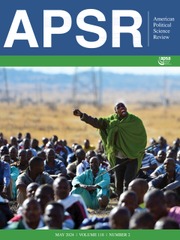Crossref Citations
This article has been cited by the following publications. This list is generated based on data provided by
Crossref.
Quek, Kai
2012.
Nuclear Proliferation and the Risk of Nuclear War: Experimental Tests.
SSRN Electronic Journal,
Quek, Kai
2012.
Nuclear Proliferation and the Risk of Nuclear Conflict: Experimental Tests.
SSRN Electronic Journal,
TOMZ, MICHAEL R.
and
WEEKS, JESSICA L. P.
2013.
Public Opinion and the Democratic Peace.
American Political Science Review,
Vol. 107,
Issue. 4,
p.
849.
Horowitz, Michael C.
2014.
Who's Afraid of 'Killer Robots'? Public Opinion and Autonomous Weapons Systems.
SSRN Electronic Journal,
Machida, Satoshi
2014.
Who Supports Nuclear Armament in Japan? Threat Perceptions and Japan's Nuclear Armament.
Asian Journal of Political Science,
Vol. 22,
Issue. 2,
p.
128.
Clifford, Scott
and
Jerit, Jennifer
2015.
Do Attempts to Improve Respondent Attention Increase Social Desirability Bias?.
Public Opinion Quarterly,
Vol. 79,
Issue. 3,
p.
790.
Kreps, Sarah E.
and
Wallace, Geoffrey P.R.
2015.
International Law, Military Effectiveness, and Public Support for Drone Strikes.
SSRN Electronic Journal,
Aronow, Peter M.
Baron, Jonathon
and
Pinson, Lauren
2015.
A Note on Dropping Experimental Subjects Who Fail a Manipulation Check.
SSRN Electronic Journal,
Reiter, Dan
2015.
The Positivist Study of Gender and International Relations.
Journal of Conflict Resolution,
Vol. 59,
Issue. 7,
p.
1301.
Butt, Ahsan I.
2015.
Do nuclear weapons affect the guns-butter trade-off? Evidence on nuclear substitution from Pakistan and beyond.
Conflict, Security & Development,
Vol. 15,
Issue. 3,
p.
229.
Holmes, Marcus
and
Traven, David
2015.
Acting Rationally Without Really Thinking: The Logic of Rational Intuitionism for International Relations Theory.
International Studies Review,
p.
n/a.
Horowitz, Michael C.
2015.
Public Opinion and the Politics of the Killer Robots Debate.
SSRN Electronic Journal,
Hyde, Susan D.
2015.
Experiments in International Relations: Lab, Survey, and Field.
Annual Review of Political Science,
Vol. 18,
Issue. 1,
p.
403.
Bell, Mark S
and
Quek, Kai
2015.
Realism, Idealism, and American Public Opinion on Nuclear Disarmament.
SSRN Electronic Journal,
Isani, Mujtaba
and
Silverman, Daniel
2016.
Foreign Policy Attitudes toward Islamic Actors.
Political Research Quarterly,
Vol. 69,
Issue. 3,
p.
571.
Sauer, Frank
2016.
Handbuch Internationale Beziehungen.
p.
1.
Koschut, Simon
2016.
Normative Change and Security Community Disintegration.
p.
1.
Gartzke, Erik
and
Kroenig, Matthew
2016.
Nukes with Numbers: Empirical Research on the Consequences of Nuclear Weapons for International Conflict.
Annual Review of Political Science,
Vol. 19,
Issue. 1,
p.
397.
Friedman, Jeffrey
Lerner, Jennifer
and
Zeckhauser, Richard J.
2016.
How Quantifying Probability Assessments Influences Analysis and Decision Making: Experimental Evidence from National Security Professionals.
SSRN Electronic Journal,
Horowitz, Michael C
2016.
Public opinion and the politics of the killer robots debate.
Research & Politics,
Vol. 3,
Issue. 1,


Comments
No Comments have been published for this article.